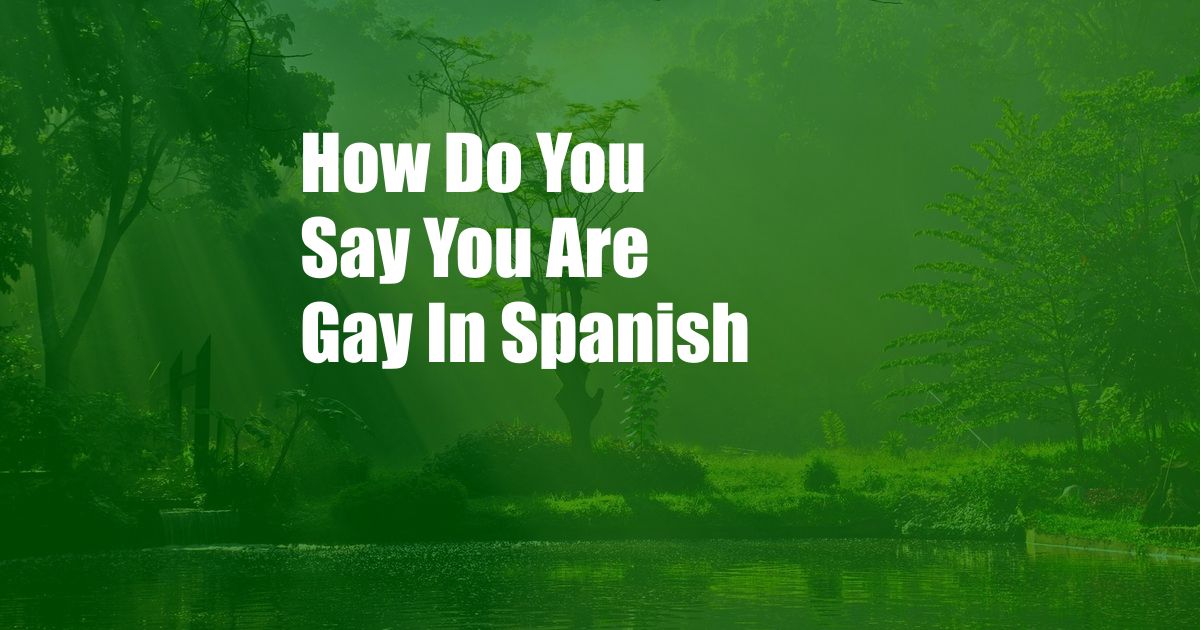
How Do You Say You Are Gay in Spanish?
Coming out as LGBTQ+ can be a daunting experience, especially if you’re not sure how to express your identity in other languages. If you’re wondering how to say you’re gay in Spanish, you’ve come to the right place. In this comprehensive guide, we’ll explore the different ways to express your sexual orientation in Spanish, providing you with the confidence to embrace your true self.
Coming out is a personal journey that requires courage and self-acceptance. Whether you’re coming out to your family, friends, or the world, it’s important to do so on your own terms. If you’re not ready to come out publicly, don’t feel pressured to do so. Take your time and find the right words and the right people to share your truth with.
Decoding the Language of Love: Expressing Your Sexual Orientation in Spanish
The Spanish language offers a rich tapestry of words and phrases to express your sexual orientation. Whether you identify as gay, lesbian, bisexual, transgender, or queer, there’s a term that resonates with your unique experience.
One of the most common ways to say you’re gay in Spanish is “soy gay.” This phrase is used by both men and women to express their homosexual orientation. Another common term is “soy lesbiana,” which is used specifically by women to identify as lesbians. If you identify as bisexual, you can say “soy bisexual.” For transgender individuals, the terms “soy transgénero” or “soy transexual” are commonly used to express their gender identity.
If you’re looking for a more gender-neutral way to express your sexual orientation, you can use the term “soy homosexual.” This term encompasses all individuals who are attracted to people of the same sex. You can also use the term “soy queer” to express your non-conformity to traditional gender and sexual norms.
Navigating the Nuances: Cultural Context and Regional Variations
While the terms mentioned above are widely used to express sexual orientation in Spanish, it’s important to note that language and cultural context can influence how these terms are perceived and used. In some Spanish-speaking countries, certain terms may carry negative connotations or be considered offensive.
For example, the term “maricón” is often used as a derogatory slur against gay men in some regions. Similarly, the term “bollera” can be used to insult lesbian women. It’s crucial to be aware of these cultural nuances and use language that is respectful and inclusive.
Tips for Coming Out in Spanish
Coming out in any language can be challenging, but it can be especially daunting if you’re not fluent in the language. Here are a few tips to help you navigate the process with confidence:
- Practice your words: Before you come out, practice saying the words you want to use in front of a mirror or with a trusted friend.
- Be clear and direct: When you come out, be clear and direct about your sexual orientation. Avoid using vague or ambiguous language.
- Be patient and understanding: Not everyone will react to your coming out in a positive way. Be patient and understanding with those who may need time to adjust.
Remember, coming out is a personal journey and there is no right or wrong way to do it. If you’re not sure how to come out, there are many resources available to help you.
Frequently Asked Questions
Q: What is the difference between “gay” and “homosexual”?
A: In Spanish, the terms “gay” and “homosexual” are often used interchangeably to refer to individuals who are attracted to people of the same sex. However, some individuals may prefer to use the term “homosexual” to describe their sexual orientation in a more formal or clinical context.
Q: How do I say “I’m transgender” in Spanish?
A: You can say “soy transgénero” or “soy transexual” to express your transgender identity in Spanish. The term “transgénero” is more commonly used to refer to individuals whose gender identity does not match the sex they were assigned at birth. The term “transexual” is often used to refer to individuals who have undergone or are considering undergoing gender-affirming surgery.
Q: Where can I find support for coming out as LGBTQ+ in Spanish?
A: There are many resources available to support LGBTQ+ individuals who are coming out or exploring their sexual orientation and gender identity. Here are a few organizations that offer support in Spanish:
- The Trevor Project: https://www.thetrevorproject.org
- PFLAG National: https://pflag.org
- GLAAD: https://www.glaad.org
Conclusion
Coming out as LGBTQ+ in Spanish can be a transformative experience, allowing you to embrace your true self and connect with others who share your identity. Whether you’re coming out to yourself, your loved ones, or the world, remember that you are not alone and that there are people who care about you and want to support you on your journey.
If you’re interested in learning more about LGBTQ+ issues in Spanish, here are a few resources:
- The Rainbow Project: https://www.rainbowproject.org
- The Human Rights Campaign: https://www.hrc.org
- The Spanish LGBTQ+ Network: https://www.redlgtb.org